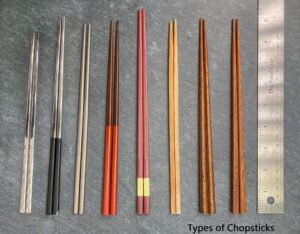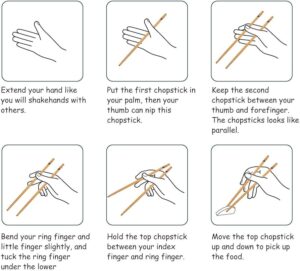Introduction
Chopsticks are not just utensils; they are a cultural symbol steeped in history and tradition. These slender sticks, typically made of wood, bamboo, or plastic, have been used for thousands of years in various cultures, particularly in East Asia. The art of using sticks transcends mere functionality; it reflects etiquette, social interactions, and a deep appreciation for food. In this comprehensive guide, we will explore the history, cultural significance, types, and proper usage of eating sticks, as well as tips for mastering this elegant tool for dining.
The History of Chopsticks
These utensils have a rich history that dates back over 3,000 years, originating in ancient China around 1200 B.C. Initially used as cooking tools, they evolved into eating implements during the Shang dynasty. As they spread throughout Asia, each culture adapted them to fit their culinary practices. For example, Japanese versions are often tapered for precision, while Korean ones are usually made of metal and flatter in design. Today, they symbolize not only a means of dining but also a deep-rooted cultural tradition that reflects respect, etiquette, and social connection.
Ancient Origins
Chopsticks date back to ancient China, around 1200 B.C. Initially, they were used for cooking, stirring, and serving food rather than for eating. Archaeological findings suggest that they evolved from cooking implements into the eating utensils we recognize today. By the time of the Shang dynasty (1600-1046 B.C.), these sticks became a common dining tool.
Spread Across Asia
From China, it spread to neighboring countries such as Japan, Korea, and Vietnam, each adapting them to their culinary practices. In Japan, for instance, these sticks often come in pairs and are sometimes intricately designed. Korean chopsticks are typically made of metal and are flatter than their Chinese counterparts, reflecting different cultural preferences and dining customs.
Evolution and Design
The design of sticks has evolved significantly over time. While traditional sticks are often made from wood or bamboo, modern variations can include materials like plastic, metal, and even ivory. The choice of material can influence the user experience, with wooden chopsticks often preferred for their grip and feel.
Cultural Significance of Chopsticks
These utensils hold profound cultural significance in many East Asian societies, transcending their role as mere tools. They embody tradition, etiquette, and respect for food and dining rituals. In countries like China, Japan, and Korea, the way chopsticks are used and presented can convey important social cues and meanings.
For example, using them to share food symbolizes friendship and community, while certain gestures, such as sticking them upright in rice, are considered impolite. This rich tapestry of customs highlights how chopsticks are intertwined with social interactions and cultural identity.
Symbol of Tradition
In many East Asian cultures, these utensils symbolize not only a means of eating but also tradition and respect. For example, in Chinese culture, the way they are presented can convey different meanings. Giving a pair as a gift can symbolize good fortune while placing them upright in a bowl of rice is associated with funeral rites and should be avoided during meals.
Etiquette and Usage
Using these utensils involves more than just picking up food; it is steeped in etiquette. In China, it is customary to avoid pointing or tapping them on bowls, as this can be perceived as impolite. Proper handling, such as not crossing them or sticking them into food, is essential to maintaining respect at the dining table.
Social Interaction
Chopsticks also play a role in social interaction during meals. In Japan, it is common to share dishes using chopsticks, emphasizing the communal aspect of dining. Sharing food is a gesture of friendship and bonding, showcasing the importance of food as a social connector.
Types of Chopsticks
Below are different types of sticks for eating purposes:

Wooden Chopsticks
Wooden chopsticks are the most traditional and widely used type. They provide a natural grip, making it easier to pick up food. They are typically lightweight and are available in various lengths and designs.
Bamboo Chopsticks
Bamboo chopsticks are similar to wooden ones but are often more environmentally friendly due to bamboo’s rapid growth. They are lightweight and usually disposable, making them popular in casual dining.
Metal Chopsticks
Metal chopsticks, often made from stainless steel, are more common in Korea. They are durable and easy to clean but can be slippery for those not accustomed to using them. Their flat design helps provide a secure grip.
Plastic Chopsticks
Plastic chopsticks are commonly used in fast-food restaurants and for takeout. They are affordable and lightweight, though they lack the traditional feel of wooden or metal chopsticks.
Specialty Chopsticks
Some chopsticks are designed for specific cuisines or uses. For example, Japanese chopsticks often feature a tapered end for precision, while thicker Chinese chopsticks may be used for heartier dishes.
How to Use Chopsticks: A Step-by-Step Guide
Using chopsticks can be a fun and rewarding skill to learn! Here’s a step-by-step guide to help you master them:
Choose the Right Chopsticks
- Material: Wooden, bamboo, plastic, or metal are common options. Beginners often find wooden or plastic chopsticks easier to grip.
- Size: Make sure the chopsticks are a comfortable length for your hands.
Hold the First Chopstick
Position the Second Chopstick refers to the next step in mastering the use of chopsticks, emphasizing the importance of proper technique in using this traditional eating utensil. Once the first chopstick is securely held between the thumb and index finger, the second chopstick is placed against the ring finger, allowing it to pivot while the first chopstick provides stability.
This technique is crucial for effectively picking up food, as the motion relies on the coordination of both sticks. Mastering this positioning not only enhances dexterity but also improves the overall dining experience, highlighting the significance of balance and control in culinary practices. Understanding and practicing this skill can also foster an appreciation for the cultural traditions associated with these sticks.
Placement Hold the second chopstick between your thumb and index finger, similar to how you hold the first one.
Balance The second chopstick should rest against the first one, near the top.
Practice Movement
Practice Movement is a critical phase in learning how to use chopsticks effectively. It involves developing the fine motor skills necessary for precise control and coordination. To start, focus on the “Open and Close” technique: use your index and middle fingers to move the top chopstick up and down while keeping the bottom chopstick stationary. This action mimics the natural pinching motion required for picking up food.
Next, the “Practice Control” step emphasizes the importance of aiming to pinch the top chopstick down to meet the bottom one without excessive lifting. This control is essential for grasping various types of food, from small grains to larger pieces, enhancing your overall proficiency. Regular practice of these movements not only builds muscle memory but also increases confidence, making dining experiences more enjoyable and efficient.

Pick Up Food
Pick Up Food is the final step in mastering chopstick use, and it combines the techniques developed in previous stages into a practical application. The first step, Apporoch, involves positioning the chopsticks around the food item you wish to pick up, ensuring that they are aligned properly to encase the item securely. Next, during the Pinch phase, gently close the top chopstick down to grip the food, applying just enough pressure to hold it without crushing or damaging the item.
Finally, the Lift step requires you to slowly and steadily elevate the food to your mouth. This movement should be controlled to prevent dropping or losing grip on the food, allowing for a smooth transition. Mastering this process not only enhances your dining etiquette but also allows you to enjoy a wide variety of dishes traditionally eaten with these sticks, enriching your culinary experiences.
Tips for Success
Learning to use chopsticks can be a fun and rewarding experience, but it does require practice and patience. To start, focus on larger foods such as chunks of vegetables or sushi, which are easier to grasp. This will help you build your confidence and develop the necessary dexterity. Regular practice is essential; try incorporating chopsticks into your meals as much as possible to improve your skills over time. Remember, it’s normal to feel a bit awkward at first, so be patient with yourself as you become more comfortable with the motion. With persistence, you’ll soon find that handling smaller items, like rice or noodles, becomes much easier.
Common Mistakes to Avoid
When it comes to improving your technique, avoiding common mistakes can make a significant difference. One frequent error is gripping too tightly. A light grip allows for better control and flexibility, helping you respond more effectively to movements. Additionally, using the correct fingers is crucial; rely on your index and middle fingers for precise actions instead of involving your whole hand. This not only enhances your dexterity but also ensures smoother, more accurate execution. By focusing on these aspects, you can elevate your performance and reduce unnecessary strain.
Tips for Mastering Chopsticks
Mastering chopsticks can elevate your dining experience, especially with Asian cuisine. By choosing the right techniques and practicing with suitable foods, you’ll quickly gain confidence and skill, making meals more enjoyable and culturally enriching.
Choose the Right Length
Selecting chopsticks that fit comfortably in your hands can make a significant difference in your control and grip. Generally, longer sticks are better for larger hands, while shorter ones are ideal for smaller hands.
Practice with Different Foods
Begin with larger, easier-to-grasp foods such as soft vegetables or chunks of meat. This builds confidence and skill before progressing to more challenging items like rice or slippery noodles.
Use Training Chopsticks
If you’re finding traditional chopsticks difficult, try training versions that have built-in holders or grooves. These can help you learn the proper technique and improve your dexterity as you practice.
Conclusion
Chopsticks are more than just a tool for eating; they embody a rich cultural heritage and an art form that enhances the dining experience. Understanding their history, significance, and proper usage can deepen your appreciation for this elegant utensil. Whether you’re enjoying sushi in a restaurant or sharing a meal with friends, mastering eating chopsticks can elevate your culinary journey. As you practice, remember that the beauty of these sticks lies in their simplicity and the connections they foster among people and food. By embracing the elegance of chopsticks, you not only enhance your dining skills but also honor a time-honored tradition that has captivated cultures for centuries.


